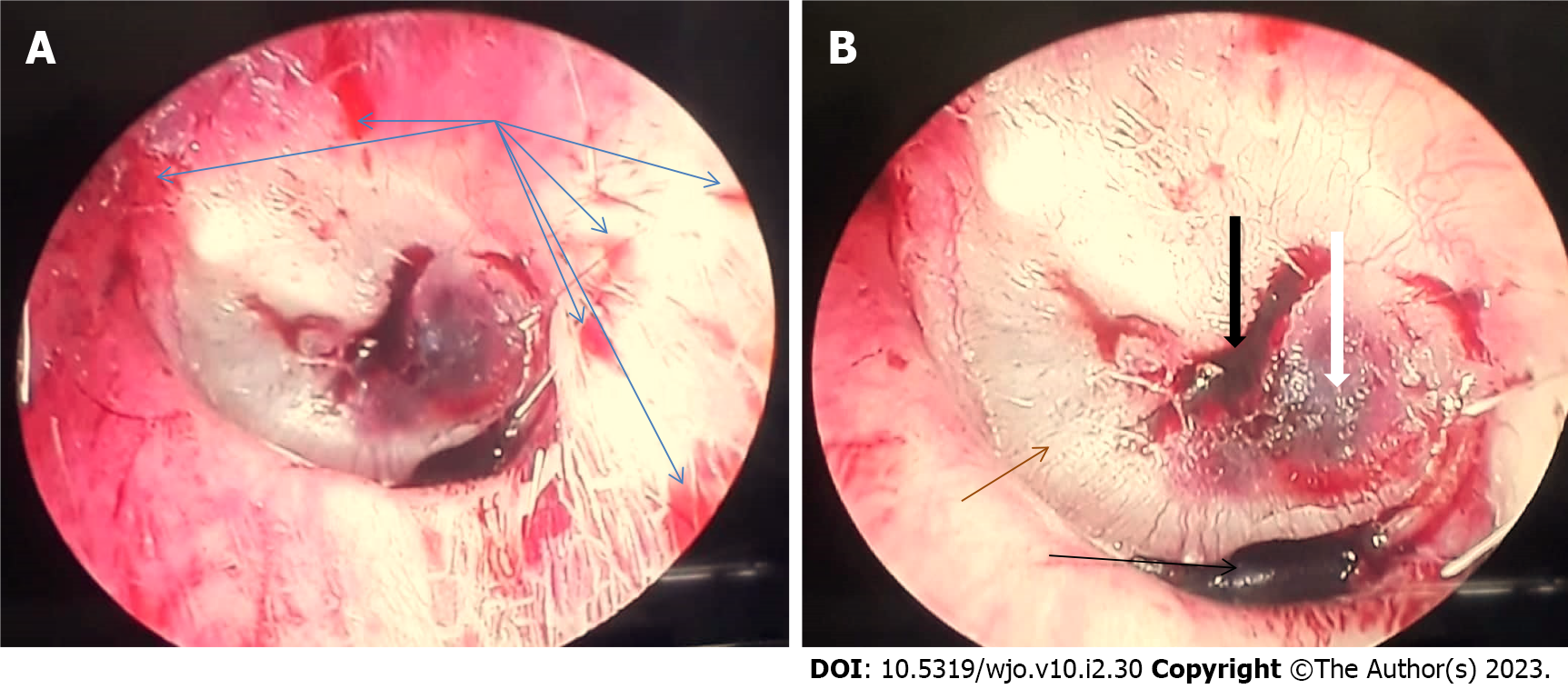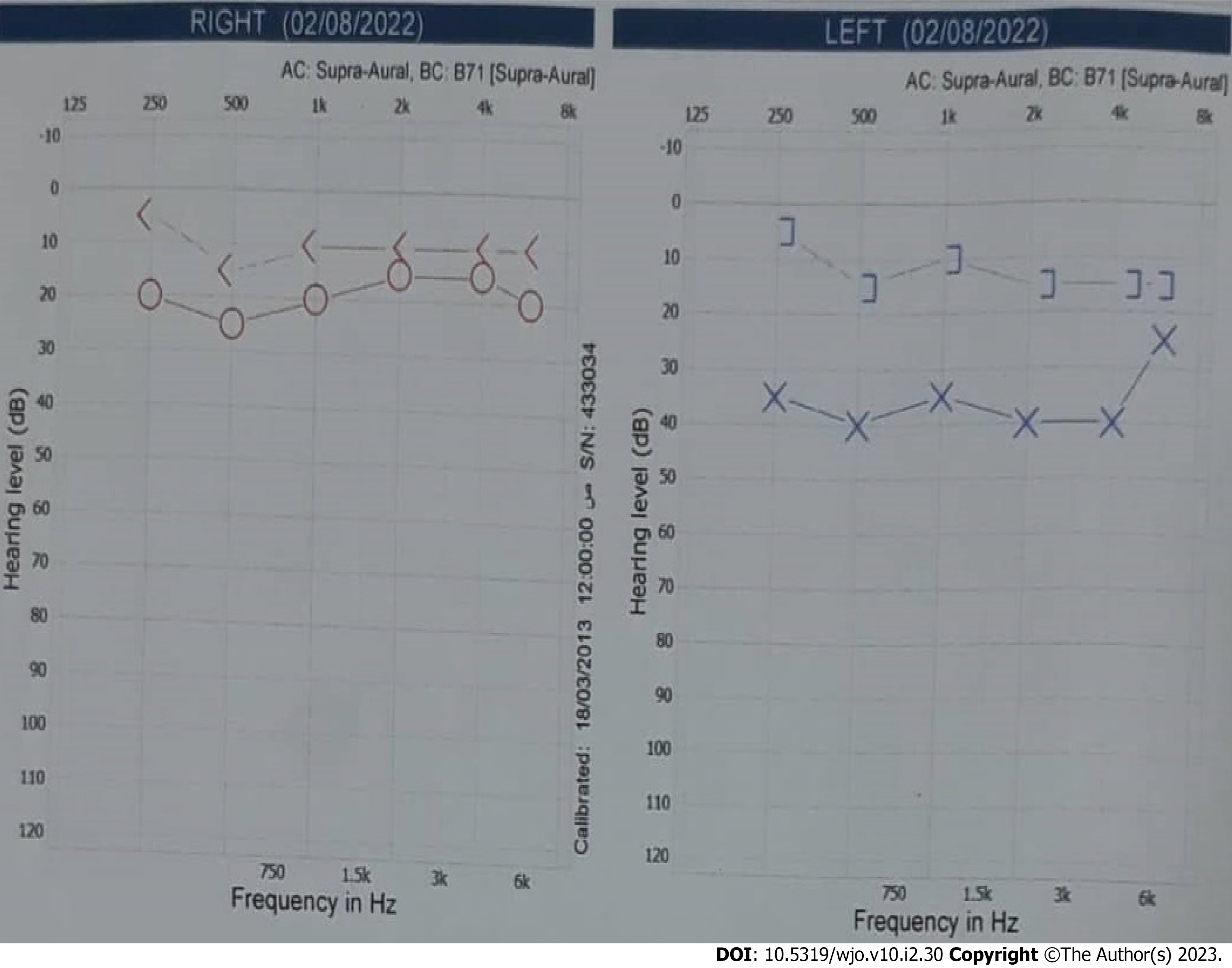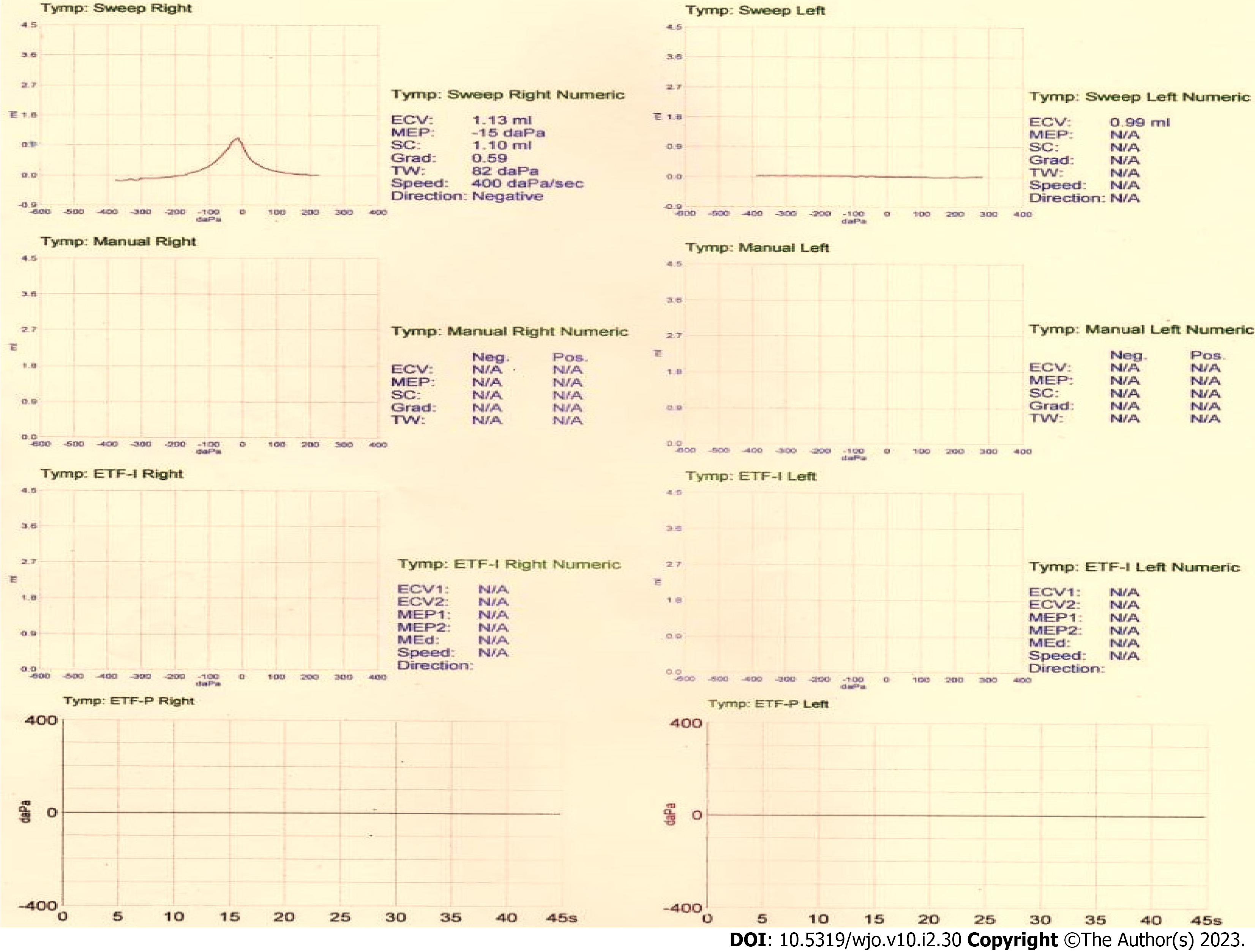Published online May 9, 2023. doi: 10.5319/wjo.v10.i2.30
Peer-review started: December 31, 2022
First decision: April 13, 2023
Revised: April 14, 2023
Accepted: April 27, 2023
Article in press: April 27, 2023
Published online: May 9, 2023
Processing time: 128 Days and 0.5 Hours
Cupping therapy is used across the globe since ancient Egypt. It is used as a complementary or alternative to daily clinical practice. Cupping therapy could be dry or wet (Al-hijamah) type. It is considered a relatively safe procedure for a variety of clinical problems like lower backache, shoulder pain, neck pain, headache, and migraine. Application of cupping therapy over body orifices is contraindicated.
A 27-year-old gentleman presented with sudden left-sided hearing loss and tinnitus for 7 d. He gave a history of upper respiratory tract infection 14 d before his complaints. He received Al-hijamah over his left ear 3 d before seeking advice from the Otolaryngology clinic, but without benefit. Physical examination showed a dull-looking left ear drum, hemotympanum in the posterior part of the tympanic cavity, two blood clots over the eardrum, and multiple bleeding points over the external ear canal and tympanic membrane. A pure tone audiogram and tympanogram confirmed the diagnosis of middle ear effusion. Conservative treatment (avoidance of water entry, antibiotics, and local and systemic de
We do not recommend using Al-hijamah directly over the ear as a treatment option for hearing loss to avoid unwanted ear trauma as well as there is no benefit from this kind of treatment.
Core Tip: Al-hijamah is a useful treatment for a variety of local and systemic diseases. However, Al-hijamah is contraindicated over the body orifices. A 27-year-old gentleman presented with left-sided hearing loss and tinnitus was treated with a Al-hijamah over the left ear. The patient condition persist as well as there were signs of bleeding (fresh blood, clots, and hemotympanum). Secretary otitis media following upper respiratory tract infection was established on clinical background and audiological tests. He was treated successfully by avoidance of water entry, antibiotics, and decongestant. We don’t recommend the usage of Al-hijamah over the ear to treat hearing loss.
- Citation: Al-Ani RM. Wet cupping (Al-hijamah) as a strange cause of ear trauma: A case report. World J Otorhinolaryngol 2023; 10(2): 30-35
- URL: https://www.wjgnet.com/2218-6247/full/v10/i2/30.htm
- DOI: https://dx.doi.org/10.5319/wjo.v10.i2.30
Wet cupping or Al-hijamah is an old traditional therapeutic procedure that is performed in many countries and referred to as the Unani part of medicine. The procedure involves bloodletting from acupoints on a subject’s skin to achieve a satisfactory result[1]. Cupping therapy has many indications, both for local (lower back pain, neck and shoulder pain, and headache) and systemic diseases like diabetes mellitus[2]. Cupping therapy should be avoided in patients with organ failure, cancer, cardiovascular diseases, increased risk of cardiovascular disorders (like high serum cholesterol level), hemophilia or other similar blood disorders, and pacemaker. It should not be applied directly over veins, arteries, nerves, skin abnormalities, eyes, body orifices, lymph nodes, and dermatological inflammation[3].
Cupping therapy, like any kind of treatment modality, has adverse effects, especially in the hands of unqualified therapists[4,5]. A recent study reported a beneficial effect of wet cupping therapy as a complementary to steroids in the treatment of a 48-year-old woman with sudden sensorineural hearing loss[6]. However, there is no other study that investigated the use of cupping therapy in the treatment of hearing loss. We reported a 27-year-old male presented with left-sided conductive hearing loss who was treated (by an inexpert) by the application of an Al-hijamah cup directly over the left ear. Unfortunately, this treatment modality was not useful in resolving the patient condition and resulted in a trauma to the external and middle ears.
Left-sided hearing loss and tinnitus.
A 27-year-old gentleman presented with sudden onset left-sided hearing loss and subjective tinnitus 7 d ago. He gave a history of upper respiratory tract infection 2 wk before his complaints. He was subjected to Al-hijamah directly over the left ear by a therapist to get rid of his presenting features. In addition to the bleeding from the affected ear following Al-hijamah, his clinical symptoms persist. There was no bruising over the affected auricle or postauricular region. The patient denied any history of otorrhea or vertigo.
The patient was healthy with no history of chronic medical diseases.
The patient had no specific personal or family history.
The patient visited an Otolaryngology clinic. Otoendoscopy revealed several bleeding points covering the left external ear canal, two blood clots, dull looking eardrum, an absent cone of light, and hemotympanum in the posterior part of the left tympanic cavity (Figure 1).
The right ear was completely normal. Tuning fork tests revealed a negative Rinne test on the left side and a positive on the right side, while the Weber test was lateralized to the left ear. Nasal endoscopy revealed clear both nasal cavities and nasopharynx apart from the congestion of the left nasopharyngeal opening of the Eustachian tube.
Audiological tests in form of pure tone audiogram, which revealed conductive hearing loss in the left ear with an air-bone gap of 37 dB (Figure 2), and a tympanogram that showed a type B curve on the left ear and a type A curve on the right side (Figure 3).
The diagnosis was left secretory otitis media superadded by ear trauma from the Al-hijamah procedure.
We advised the patient to avoid water entry to his left ear, antibiotic cover (amoxicillin 500 mg three times daily for 5 d), nasal decongestant drops (0.05% xylometazoline nasal drops 3 drops for each nostril three time daily for five days), and a combination of systemic decongestant and analgesia tablets (one tablet per day for five days).
At two weeks follow-up, there was a full recovery of all the presenting symptoms, and the left ear canal and ear drum returned to normal.
Cupping therapy is used as a complementary or alternative to the usual practice of medicine. It was practiced since ancient Egypt across the globe. It is useful for the management of a wide range of local or systemic clinical problems[7]. The exact therapeutic mechanism of action is not yet described even though an increasing number of investigations include a meta-analysis[8].
Cupping therapy is considered a safe procedure and is part of complementary and alternative medicine. However, frequent cupping treatment over a short period may result in generalized weakness, unsteadiness or drowsiness, and light headiness[9]. Other adverse effects might lead to bruising and skin discoloration, ecchymosis, bleeding, anemia, skin pigmentation, blisters, wound infection, and abscesses, particularly, if cupping therapy is performed by an unqualified or inexpert person[4,5]. However, ear trauma due to Al-hijamah, as in our case, is not reported.
Ear trauma usually occurs in young adult men owing to the high outdoor activities. It is usually caused during personal assaults, sports, or following personal accidents and road traffic accidents. Ear injury results in various clinical problems depending on the velocity and mechanism of the injury. These include; hematoma auris, lacerations or wounds, partial or complete avulsion of the auricle, hemotympanum, eardrum perforation, dislocation of the ossicles, Otic barotrauma, facial palsy, and inner ear injury[10]. Although, Al-hijamah is widely used in Iraq due to cultural and religious beliefs and resulted in the improvement of many conditions like diabetes mellitus, hypertension, and hyperlipidemia, treatment for hearing loss is not used before[11]. A recent case report study from Qatar reported that Al-hijamah is used for the treatment of sudden sensorineural hearing loss as a complementary treatment with steroids in a 48-year-old woman with satisfactory results[6]. To our best knowledge, there is no other study in the world that used cupping therapy as a treatment modality for hearing loss. Unfortunately, in the presenting case, cupping therapy was applied directly on the auricle resulting in hemotympanum and bleeding from the ear without improvement of the patient complaints (hearing loss and tinnitus). We do not recommend using Al-hijamah directly over the ear to avoid unwanted ear injuries as well as there is no benefit from its use. Furthermore, this study supports that cupping therapy is contraindicated over body orifices[3].
The direct application of cupping therapy on the external meatus results in bleeding from the ear canal and haemotympanum as well as there was no improvement of the patients' hearing loss. Therefore, we do not recommend using Al-hijamah directly on the ear.
Provenance and peer review: Unsolicited article; Externally peer reviewed.
Peer-review model: Single blind
Specialty type: Otorhinolaryngology
Country/Territory of origin: Iraq
Peer-review report’s scientific quality classification
Grade A (Excellent): 0
Grade B (Very good): B
Grade C (Good): C, C, C
Grade D (Fair): 0
Grade E (Poor): 0
P-Reviewer: Mahmoud MZ, Saudi Arabia; Mirsalehi M, Iran S-Editor: Fan JR L-Editor: A P-Editor: Zhao S
| 1. | Almaiman AA. Proteomic effects of wet cupping (Al-hijamah). Saudi Med J. 2018;39:10-16. [RCA] [PubMed] [DOI] [Full Text] [Full Text (PDF)] [Cited by in Crossref: 8] [Cited by in RCA: 9] [Article Influence: 1.3] [Reference Citation Analysis (0)] |
| 2. | Aboushanab TS, AlSanad S. Cupping Therapy: An Overview from a Modern Medicine Perspective. J Acupunct Meridian Stud. 2018;11:83-87. [RCA] [PubMed] [DOI] [Full Text] [Cited by in Crossref: 44] [Cited by in RCA: 62] [Article Influence: 8.9] [Reference Citation Analysis (1)] |
| 3. | Furhad S, Bokhari AA. Cupping Therapy. 2023 Jan 2. In: StatPearls [Internet]. Treasure Island (FL): StatPearls Publishing; 2023 Jan-. [PubMed] |
| 4. | Refaat B, El-Shemi AG, Ebid AA, Ashshi A, BaSalamah MA. Islamic wet cupping and risk factors of cardiovascular diseases: effects on blood pressure, metabolic profile and serum electrolytes in healthy young adult men. Altern Integ Med. 2014;3:151. [DOI] [Full Text] |
| 5. | Vaccaro M, Coppola M, Ceccarelli M, Montopoli M, Guarneri C. The good and the bad of cupping therapy: case report and review of the literature. Eur Rev Med Pharmacol Sci. 2021;25:2327-2330. [RCA] [PubMed] [DOI] [Full Text] [Reference Citation Analysis (0)] |
| 6. | Almusleh ZA, El Ansari W. Integrating Cupping Therapy in the Management of Sudden Sensorineural Hearing Loss: A Case Report. Cureus. 2020;12:e7063. [RCA] [PubMed] [DOI] [Full Text] [Full Text (PDF)] [Cited by in RCA: 2] [Reference Citation Analysis (0)] |
| 7. | Choi TY, Ang L, Ku B, Jun JH, Lee MS. Evidence Map of Cupping Therapy. J Clin Med. 2021;10. [RCA] [PubMed] [DOI] [Full Text] [Full Text (PDF)] [Cited by in Crossref: 4] [Cited by in RCA: 25] [Article Influence: 6.3] [Reference Citation Analysis (0)] |
| 8. | Al-Bedah AMN, Elsubai IS, Qureshi NA, Aboushanab TS, Ali GIM, El-Olemy AT, Khalil AAH, Khalil MKM, Alqaed MS. The medical perspective of cupping therapy: Effects and mechanisms of action. J Tradit Complement Med. 2019;9:90-97. [RCA] [PubMed] [DOI] [Full Text] [Full Text (PDF)] [Cited by in Crossref: 51] [Cited by in RCA: 101] [Article Influence: 14.4] [Reference Citation Analysis (0)] |
| 9. | Kim KH, Kim TH, Hwangbo M, Yang GY. Anaemia and skin pigmentation after excessive cupping therapy by an unqualified therapist in Korea: a case report. Acupunct Med. 2012;30:227-228. [RCA] [PubMed] [DOI] [Full Text] [Cited by in Crossref: 16] [Cited by in RCA: 17] [Article Influence: 2.4] [Reference Citation Analysis (0)] |
| 10. | Eagles K, Fralich L, Stevenson JH. Ear trauma. Clin Sports Med. 2013;32:303-316. [RCA] [PubMed] [DOI] [Full Text] [Cited by in Crossref: 9] [Cited by in RCA: 10] [Article Influence: 0.8] [Reference Citation Analysis (0)] |
| 11. | Rahman HS, Ahmad GA, Mustapha B, Al-Rawi HA, Hussein RH, Amin K, Othman HH, Abdullah R. Wet cupping therapy ameliorates pain in patients with hyperlipidemia, hypertension, and diabetes: A controlled clinical study. Int J Surg Open. 2020;26:10-15. [RCA] [DOI] [Full Text] [Cited by in Crossref: 1] [Cited by in RCA: 1] [Article Influence: 0.2] [Reference Citation Analysis (0)] |











